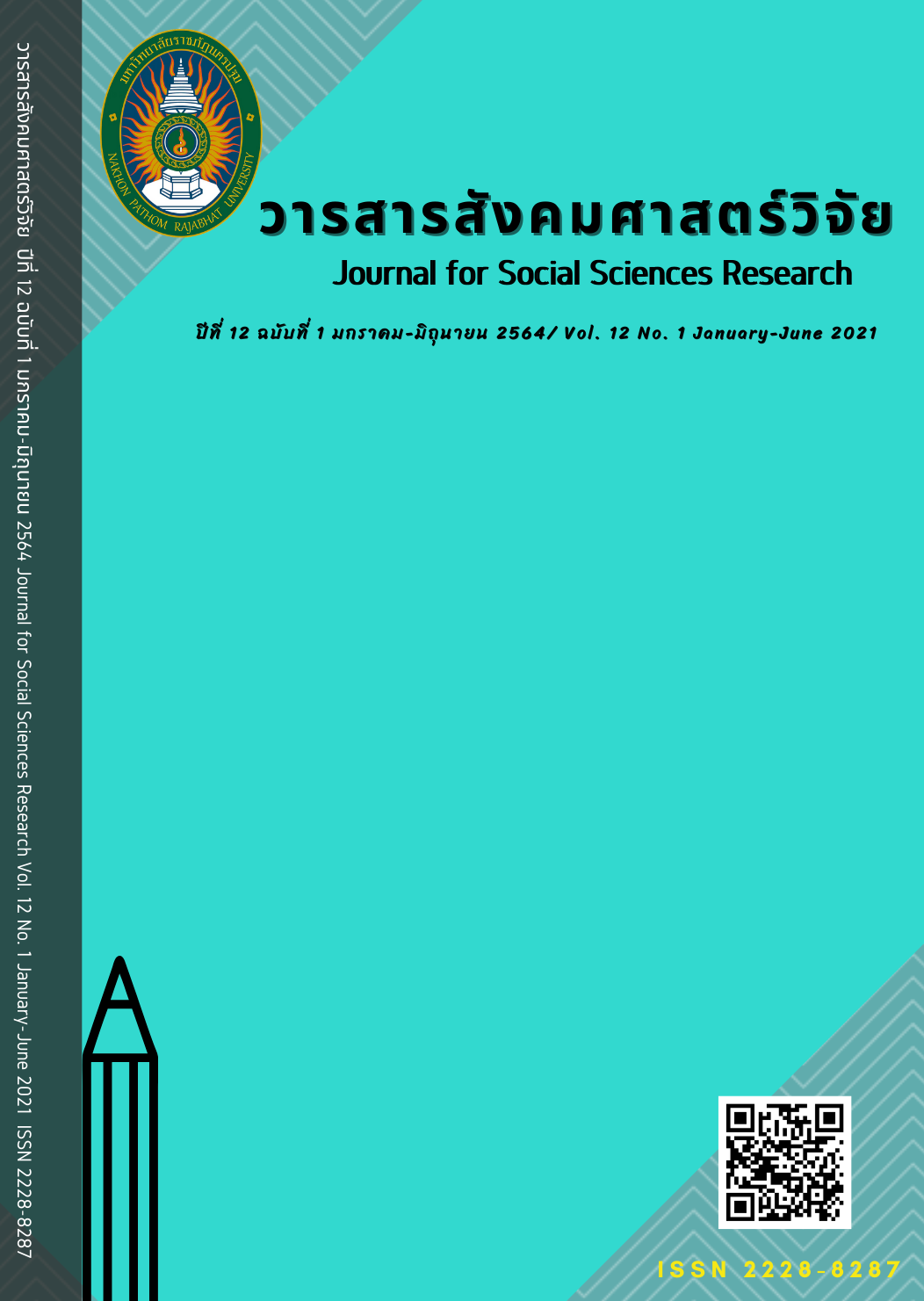MODEL OF GUIDANCE ACTIVITY TO ENHANCE CREATIVE PROBLEM SOLVING ABILITIES AND COUNSELING INNOVATION ABILITIES OF YOUTH COUNSELOR STUDENTS, LOWER SECONDARY SCHOOL LEVEL
Main Article Content
Abstract
The purposes of this research were to: 1) develop and determine the efficiency of model of guidance activity; 2) evaluate the effectiveness of model of guidance activity; and 3) disseminate the model of guidance activity. The sample were 37 students in 7th – 9th grade who was studying in the second semester of the academic year 2019 at Donkhawittaya School under the Office of the Secondary Educational Service Area 9, derived by purposive sampling. A total of 20 hours of experiments were performed using the one group pretest-posttest design and the 3 phase development studies. The research instruments consisted of a model of guidance activity, a unit manual and an activity plan, a group behavior observation form, an evaluation form for creative problem-solving and counseling innovation ability, a work skill assessment form for those relating to organizing “Youth Counselor Students” presentation activity; and a reflecting journal of guidance activities. The data was analyzed with mean, standard deviation, dependent t-test, and content analysis.
The research results showed that:
- The model of guidance activity, named “PECCAP”, consists of 5 components. These are: 1) Principles. It should focus on students to create their own knowledge systematically through the form of guidance activities, by integrating 5 teaching models: (1) guidance activity learning, (2) activity-based learning, (3) case-based learning, (4) problem-based learning, and (5) inquiry-based learning, which are under the principle of guidance activities, constructivism theory, humanism theory, Piaget's theory of cognitive development, and cooperative learning. 2) Objectives. The objective is to enhance creative problem solving and counseling innovation ability. 3) Learning process. There are 6 steps of activity, PECCAP: (1) preparing students (P), (2) exploring and searching for hypothetical data (E), (3) collecting, analyzing and discussing the data (C), (4) creating a new concept (C), (5) asking questions to create alternatives or solutions (A), and (6) presenting and summarizing the evaluation results (P). 4) Assessment and evaluation. The assessment and evaluation are conducted in 8 aspects of creative problem-solving and counseling innovation ability with 14 indicators. 5) Supporting factors. The supporting factors are (1) personnel who are related and give cooperation in activities, set the atmosphere to facilitate learning, and participate in evaluating the results of creative problem-solving, counseling innovation ability, and learners’ presented performance in actual condition; and (2) students who is diligent to study in a systematic manner, systematically record the results of counseling and make reports to present to relevant persons under the supervision of experts. The efficiency of this model (E1/E2) was 85.23/86.01.
- The effectiveness of the developed model indicated that 2.1) after participating in the guidance activities based on the model, students’ creative problem-solving and counseling innovation ability were higher than that of before at statistical significance level of .05; 2.2) after participating in the guidance activities based on the model, students developed the creative problem-solving at a high level; and 2.3) after participating in the guidance activities based on the model, students developed the counseling innovation ability at a high level.
- The results of the dissemination using model of guidance activity indicated that creative problem solving abilities and counseling innovation abilities for lower secondary school students after using the model were significantly higher than before the instruction at .05
Article Details
บทความที่ได้รับการตีพิมพ์เป็นลิขสิทธิ์ของมหาวิทยาลัยราชภัฏนครปฐม
เนื้อหาของแต่ละบทความเป็นทัศนะของผู้เขียน ซึ่งที่ปรึกษา บรรณาธิการ กองบรรณาธิการ และคณะกรรมการบริหารวารสารไม่จำเป็นต้องเห็นด้วย หรือร่วมรับผิดชอบใดๆ
References
กระทรวงศึกษาธิการ และสมาคมแนะแนวแห่งประเทศไทย. (2561). มาตรฐานการแนะแนว (พิมพ์ครั้งที่ 3). กรุงเทพฯ: ชุมนุมสหกรณ์การเกษตรแห่งประเทศไทย.
กัญญารัตน์ โคจร. (2554). การพัฒนารูปแบบการเรียนรู้ การแก้ปัญหาอย่างสร้างสรรค์ (CPS Learning Model) เรื่องสารและสมบัติของสาร สำหรับนักเรียนชั้นมัธยมศึกษาปีที่ 1. วิทยานิพนธ์การศึกษาดุษฎีบัณฑิต สาขาวิชาวิทยาศาสตรศึกษา บัณฑิตวิทยาลัย มหาวิทยาลัยศรีนครินทรวิโรฒ.
เกศสุดา แสนนามวงษ์. (2559, สิงหาคม-พฤษภาคม). การพัฒนารูปแบบการเรียนการสอนกิจกรรมแนะแนวโดยใช้ทฤษฎีพหุปัญญาเป็นฐานเพื่อพัฒนาทักษะชีวิตสำหรับนักเรียนชั้นมัธยมศึกษาปีที่ 1. วารสารราชพฤกษ์ บัณฑิตวิทยาลัย มหาวิทยาลัยราชภัฏนครราชสีมา, 14 (2), 91-98.
คชากฤษ เหลี่ยมไธสง. (2554). การพัฒนารูปแบบการเรียนการสอนบนเว็บแบบผสมผสานโดยใช้กระบวนการแก้ปัญหาอย่างสร้างสรรค์เพื่อพัฒนาความคิดสร้างสรรค์ของนิสิตระดับอุดมศึกษา. วิทยานิพนธ์ปรัชญาดุษฎีบัณฑิต สาขาวิชาหลักสูตรและการสอน บัณฑิตวิทยาลัย มหาวิทยาลัยมหาสารคาม.
นิวัฒน์ บุญสม. (2556). การพัฒนารูปแบบการเรียนการสอนตามแนวคิดของกระบวนการแก้ปัญหาอย่างสร้างสรรค์เพื่อส่งเสริมนวัตกรรมด้านสุขภาพของนักเรียนที่มีความสามารถพิเศษทางวิทยาศาสตร์. วิทยานิพนธ์ปรัชญาดุษฎีบัณฑิต สาขาวิชาหลักสูตรและการสอน บัณฑิตวิทยาลัย มหาวิทยาลัยศิลปากร.
บุญเลิศ คำปัน. (2560, มกราคม-มีนาคม). การใช้กิจกรรมแนะแนวเพื่อเพิ่มแรงจูงใจใฝ่สัมฤทธิ์และผลสัมฤทธิ์ทางการเรียนของนักเรียนระดับชั้นมัธยมศึกษาปีที่ 2. วารสารวิชาการมหาวิทยาลัยฟาร์อีสเทอร์น, 11 (1), 128-134.
ปภัสราภรณ์ ระว้า และธัญญพร ศรีวิเชียร. (2561, พฤษภาคม-สิงหาคม). การพัฒนาแนวทางการจัดกิจกรรมพัฒนาผู้เรียนด้านกิจกรรมแนะแนวสำหรับสถานศึกษา สังกัดสำนักงานเขตพื้นที่การศึกษาประถมศึกษาหนองบัวลำภู เขต 2. วารสารวไลยองลกรณ์ปริทัศน์, 9 (2), 68–80.
ประจิม เมืองแก้ว, ภูฟ้า เสวกพันธ์ และเอื้อมพร หลินเจริญ. (2559, เมษายน-มิถุนายน). การพัฒนารูปแบบการจัดกิจกรรมแนะแนวตามแนวคิดจิตตปัญญาการศึกษาเพื่อเสริมสร้างการเห็นคุณค่าในตนเองสำหรับนักเรียนชั้นมัธยมศึกษาปีที่ 3. วารสารศึกษาศาสตร์ มหาวิทยาลัยนเรศวร, 18 (2), 50–59.
พีชญาณ์ พานะกิจ. (2558). การพัฒนารูปแบบการสอนเพื่อส่งเสริมความสามารถในการแก้ปัญหาอย่างสร้างสรรค์และนวตักรรมทางวิทยาศาสตร์ของนักเรียนชั้นประถมศึกษา. วิทยานิพนธ์ปรัชญาดุษฎีบัณฑิต สาขาวิชาหลักสูตรและการสอน บัณฑิตวิทยาลัย มหาวิทยาลัยศิลปากร.
พัชรา พุ่มพชาติ. (2552). การพัฒนารูปแบบการจัดประสบการณ์การแก้ปัญหาอย่างสร้างสรรค์สำหรับเด็กปฐมวัย. วิทยานิพนธ์ปรัชญาดุษฎีบัณฑิต สาขาวิชาหลักสูตรและการสอน บัณฑิตวิทยาลัย มหาวิทยาลัยศิลปากร.
ภัทรมน ขันธาฤทธิ์. (2551). การสร้างชุดการสอนกิจกรรมแนะแนวเพื่อพัฒนาการคิดวิเคราะห์ของนักเรียนชั้นประถมศึกษาปีที่ 6 โรงเรียนวัดบำเพ็ญเหนือ เขตมีนบุรี กรุงเทพมหานคร. วิทยานิพนธ์การศึกษามหาบัณฑิต สาขาวิชาจิตวิทยาการแนะแนว บัณฑิตวิทยาลัย มหาวิทยาลัยศรีนครินทรวิโรฒ.
รุจิราพร รามศิริ. (2556). การพัฒนารูปแบบการเรียนการสอนวิทยาศาสตร์โดยใช้การวิจัยเป็นฐานเพื่อเสริมเสริมสร้างทักษะการวิจัย ทักษะการแก้ปัญหาอย่างสร้างสรรค์ และจิตวิทยาศาสตร์ของนักเรียนระดับมัธยมศึกษา. วิทยานิพนธ์ปรัชญาดุษฎีบัณฑิต สาขาวิชาหลักสูตรและการสอน
บัณฑิตวิทยาลัย มหาวิทยาลัยศิลปากร.
วัชรา เล่าเรียนดี. (2555). รูปแบบและกลยุทธ์การจัดการเรียนรู้ เพื่อพัฒนาทักษะการคิด. นครปฐม: คณะศึกษาศาสตร์ มหาวิทยาลัยศิลปากร.
วิจารณ์ พานิช. (2556). งานสำคัญของการศึกษาไทย สร้าง “ทักษะ” ให้ผู้เรียนพร้อมสู่ศตวรรษที่ 21. กรุงเทพฯ: อักษรเจริญทัศน์.
ศรีวรรณ ฉัตรสุริยวงศ์. (2557). กระบวนทัศน์การจัดการเรียนรู้โดยใช้ชุมชนเป็นฐานเพื่อส่งเสริมความสามารถด้านการคิดอย่างมีวิจารณญาณและการแก้ปัญหาเชิงสร้างสรรค์สำหรับนักเรียนประถมศึกษา. วิทยานิพนธ์ปรัชญาดุษฎีบัณฑิต สาขาวิชาหลักสูตรและการสอน บัณฑิตวิทยาลัย มหาวิทยาลัยศิลปากร.
สายหยุด มีฤกษ์ และชาติชาย พิทักษธนาคม. (2561, มกราคม-มีนาคม). การใช้กิจกรรมแนะแนวเชิงพุทธเพื่อส่งเสริมทักษะชีวิตด้านการจัดการเรียน เวลา และความสัมพันธ์ของนักเรียนมัธยมศึกษาในเขตกรุงเทพมหานครและปริมณฑล. วารสารมหาจุฬานาครทรรศน์ สำนักวิชาการ มหาวิทยาลัยมหาจุฬาลงกรณราชวิทยาลัย วิทยาเขตนครศรีธรรมราช, 16 (1), 268–285.
สิทธิชัย ชมพูพาทย์. (2554). การพัฒนาพฤติกรรมการเรียนการสอนเพื่อการแก้ปัญหาอย่างสร้างสรรค์ของครูและนักเรียนในโรงเรียนส่งเสริมนักเรียนที่มีความสามารถพิเศษทางคณิตศาสตร์โดยใช้การวิจัยปฏิบัติการเชิงวิพากษ์. วิทยานิพนธ์วิทยาศาสตรดุษฎีบัณฑิต สาขาวิชาการวิจัยพฤติกรรมศาสตร์ประยุกต์ บัณฑิตวิทยาลัย มหาวิทยาลัยศรีนครินทรวิโรฒ.
อารี พันธ์มณี. (2557). ความคิดสร้างสรรค์. กรุงเทพฯ: ต้นอ้อ.
Arbesman, M. & Puccio, G. (2001). Enhanced quality through creative problem teams. Journal of Nursing Administration, 31, 176-178.
Burden, P. R. (2003). Classroom management: Creating a successful learning environment (2nd ed.). Hoboken, NJ: Wiley.
Campbell, D. T. & Stanley, J. C. (1966). Experimental and quasi-experimental design for research. Hope-Well, NJ: Houghton Mifflin.
Greene, R. W. (2008). Lost at school: Why our kids with behavioral challenges are feeling through the cracks and how we can help them. New York: Scribner.
Joyce, B., Weil, M. & Calhoun, E. (2009). Model of teaching. Boston: Allyn and Bacon.
Mitchell, W. E. & Kowalik, T. F. (1999). Creative problem solving (3rd ed.). Bangkok: Chulalongkorn University Press.
Osbom, A. F. (1963). Creative Imagination (3rd ed.). New York: Charies Scribners Sons.
Osborn, A. F. (1957). Applied imagination. New York: Charles Scribners.
Torrance, E. P. (1965). Guiding creative talent. Englewood Cliffs, N.J.: Prentice-Hall.
Treffinger, D. J. (2008). Creative problem solving (CPS) in education. Creative Learning Today, 15 (3), 1-7.
Watson, M. (2003). Learning to trust: Transforming difficult elementary classroom through development discipline. San Francisco: Jossey-Bass.


